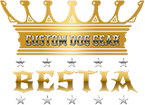Rottweiler - calm, confident and courageous dog
The Rottweiler is a breed of domestic dog, regarded as medium-to-large or large. The dogs were known in German as Rottweiler Metzgerhund, meaning Rottweil butchers' dogs, because one of their uses was to herd livestock and pull carts laden with butchered meat to market. This continued until the mid-19th century when railways caused droving to be replaced with herding. Rottweilers are now used as search and rescue dogs, as guide dogs for the blind, as guard dogs and police dogs.
History
The Rottweiler is one of the oldest of herding breeds. With a history possibly dating back to the Roman Empire, the Rottweiler may be a descendant of ancient Roman drover dogs; a mastiff-type dog that was a dependable, rugged dog with great intelligence and guarding instincts. During their quest to conquer Europe, the Roman legions traveled in large numbers across the continent. The non-existence of refrigeration meant the soldiers had to bring herds of cattle for food. The drover dogs were used to keep the herds of cattle together and to guard the herds at night. Around A.D. 74 the Roman army travelled across the Alps and into what is now southern Germany. For the next two centuries the Roman drover dogs were continually used in herding and driving cattle for trade even after the Romans were driven out of the area by the Swabians.
A town in this region was eventually given the name Rottweil. It became an important trade center and the descendants of the Roman cattle dogs proved their worth by driving the cattle to market and protecting the cattle from robbers and wild animals. The dogs are said to have been used by traveling butchers at markets during the Middle Ages to guard money pouches tied around their necks. The dogs eventually came to be called Rottweiler Metzgerhunds, or butcher dogs. As railroads became the primary method for moving stock to market, the need for the breed declined, as did the number of Rottweilers. The number of Rottweilers diminished so severely that by 1882 in a dog show in Heilbronn, there was only one very poor representative of the breed.
The buildup to World War I saw a great demand for police dogs, and that led to a revival of interest in the Rottweiler. During the First and Second World Wars, Rottweilers were put into service in various roles, including as messenger, ambulance, draught, and guard dogs.
Technical description
"Rottweiler breeders aim at a dog of abundant strength, black coated with clearly defined rich tan markings, whose powerful appearance does not lack nobility and which is exceptionally well suited to being a companion, service and working dog." This breed is all about balance, endurance, proportionality, intelligence and strength. The various standards in place for the Rottweiler's physical appearance specify these characteristics.
Temperament
Rottweilers are a powerful breed with well-developed genetic herding and guarding instincts. Potentially dangerous behavior in Rottweilers usually results from irresponsible ownership, abuse, neglect, or lack of socialization and training. However, the exceptional strength of the Rottweiler is an additional risk factor not to be neglected. It is for this reason that breed experts declare that formal training and extensive socialization are essential for all Rottweilers. According to the AKC, Rottweilers love their owners and may behave in a clownish manner toward family and friends, but they are also protective of their territory and do not welcome strangers until properly introduced. Obedience training and socialization are required.
Working style
According to the American Kennel Club, Rottweilers have a natural gathering style with a strong desire to control. They generally show a loose eye and have a great amount of force while working well off the stock. They make much use of their ability to intimidate.
The Rottweiler often carries the head on an even plane with the back, or carries the head up but with the neck and shoulders lowered. Some females lower the entire front end slightly when using their eyes. Males also do this when working far off the stock in an open field. This is rarely seen in males when working in confined spaces such as stock yards.
The Rottweiler has a reasonably good natural balance, force-barks when necessary, and when working cattle uses a very intimidating charge. There is a natural change in forcefulness when herding sheep. When working cattle, it may use its body and shoulders and for this reason should be used on horned stock with caution.
Health
Rottweilers are a relatively healthy, disease-free breed. As with most large breeds, hip dysplasia can be a problem.
As with any breed, hereditary conditions occur in some lines. The Rottweiler is very prone to osteosarcoma which is among the most common causes of early death in Rottweilers. For unknown reasons, Rottweilers are more susceptible than other breeds to become infected with parvovirus, a highly contagious and deadly disease of puppies and young dogs.
If overfed or under-exercised, Rottweilers are prone to obesity. Some of the consequences of obesity can be very serious, including arthritis, breathing difficulties, diabetes, heart failure, reproductive problems, skin disease, reduced resistance to disease and overheating caused by the thick jacket of fat under the skin.
Breed surveys in the US, UK and Denmark, and UK vet data puts the average lifespan of Rottweilers at 8 to 10 years.
As with the vast majority of large-breed dogs, Rottweilers are also predisposed to hypertrophic cardiomyopathy.
502 comments
CiyFUpLoGH
I have now owned a wonderful ex service IED bomb detection dog for 20 months. He was retired from Afghanistan back in late 2017 when I aquired him. He’s a Rottweiler now 70 kg and six and a half years old. The best well behaved dog ever. He was suffering PTSD when I got him but he is settled and happy now in his furever home.
































